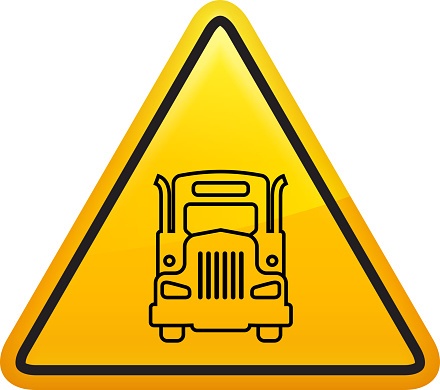How Many Blind Spots Do Trucks Have?

If you’re a practicing car accident attorney and want to start handling commercial truck accident cases, this article is for you.
What Are Blind Spots?
A blind spot is an area outside a vehicle where a driver cannot see. Blind spots are sometimes called no zones, probably for a good reason. Virtually all different types of vehicles have blind spots, but trucks have the largest blind spots on the road.
Typical passenger vehicles are outfitted with rear view and side-view mirrors that can decrease blind spots. Many new vehicles have even more technology devoted to reducing blind spots and blind spot collisions, including rear and side-view cameras, blind spot detectors, and systems that alert drivers when there is another vehicle in their blind spot. In contrast, most trucks like tractor trailers, commercial trucks, and semi-haulers do not have these advanced features and do not have rearview mirrors, which creates one major blind spot immediately behind the truck’s trailer.
Where Are the Blinds Spots Around a Truck
On average, semi-trucks in the United State are approximately 72 feet long, 8.5 feet wide and 13.5 feet tall. There are blinds spots on all four sides of a semi-truck. Due to the height of a semi-truck, its front blind spot can extend further than 20 feet. The largest blind spot on a semi-truck is on its right side. The right-side blind spot expands backwards at an angle and can extend as many as three lanes to the right.
In contrast, the blind spot on the left side of a semi-truck can extend up to two lanes. Many semi-trucks do not have rearview mirrors or cameras, which means there is no visibility directly behind the trailer. This rear blind spot can extend more than thirty feet.
How Often Do Accidents Happen in a Truck’s Blind Spot?
According to the Federal Motor Carrier Safety Administration (FMCSA), one-third of all collisions between semi-trucks and cars take place in blind spots. Most blind spot accidents occur due to the truck driver’s limited visibility. Common blind spot accident scenarios include motorists lingering in semi-truck’s blind spot areas and truck drivers failing to clear their blind spots prior to changing lanes on a highway or when making a wide turn.
The Physics of Motor-Vehicle Accidents
Semi-trucks weigh much more than passenger vehicles. Passenger vehicles typically weigh between 2,500 and 5,000 pounds. Semi-trucks on the other hand, when fully loaded, can weigh as much as 80,000 pounds. It takes 40% longer to stop semi-trucks than passenger vehicles traveling at the same speed.
According to Newton’s First Law of Motion, an object will not change its motion unless a force acts on it. This means that an individual inside of a moving vehicle will continue moving in the same direction as the vehicle until a force acts upon it. This can be exemplified when looking at the common scenario of one vehicle striking the rear end of another vehicle. In such an instance, upon impact, the rear vehicle is affected by an external and unbalanced force, causing it to quickly decelerate to rest. When this happens, the occupant of the rear vehicle will continue moving in the same direction until it is affected by another force. This other force could be a seatbelt or, in more unfortunate circumstances, a windshield and anything the individual strikes after being ejected from the vehicle. This law can be observed on a deeper level when looking at the organs of an occupant involved in a motor vehicle collision. The organs will continue traveling in the same direction until they are affected by another force, which in most cases is the skull or rib cage.
Newton’s Second Law of Motion tells us that the force on an object is equal to its mass times its acceleration. This means that the forces involved in a collision between two vehicles are directly proportionate to the mass of the vehicles. Consequently, crashes involving semi-trucks involve higher forces.
Newton’s Third Law of Motion says that when two objects interact, they apply forces to each other of equal magnitude and opposite direction. In essence, a force is a push or a pull on a particular object due to interaction with that object. In the context of a vehicle hitting a stationary semi-truck, it means that the stationary semi-truck hits back and exerts the same amount of force upon the car.
Closing Thoughts
Motor-vehicle accidents are unfortunate events that can lead to life-altering injuries or sometimes even death. The stakes become higher when one of the vehicles involved is a semi-truck. Because of this, great effort should be given by all drivers to avoid risky situations. One major practice all passenger vehicle operators can institute is avoiding semi-truck blind spot areas.









